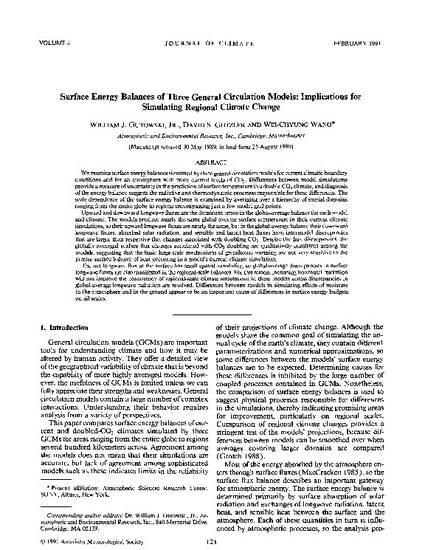
Article
Surface Energy Balances of Three General Circulation Models: Implications for Simulating Regional Climate Change
Journal of Climate
(1991)
Abstract
We examine surface energy balances simulated by three general circulation models for current climatic boundary conditions and for an atmosphere with twice current levels of CO2. Differences between model simulations provide a measure of uncertainty in the prediction of surface temperature in a double-CO2 climate, and diagnosis of the energy balance suggests the radiative and thermodynamic processes responsible for these differences. The scale dependence of the surface energy balance is examined by averaging over a hierarchy of spatial domains ranging from the entire globe to regions encompassing just a few model grid points.
Upward and downward longwave fluxes are the dominant terms in the global-average balance for each model and climate. The models product nearly the same global-average surface temperature in their current climate simulations, so their upward longwave fluxes are nearly the same, but in the global-average balance their downward longwave fluxes, absorbed solar radiation, and sensible and latent heat fluxes have intermodel discrepancies that are larger than respective flux changes associated with doubling CO2. Despite the flux discrepancies, the globally averaged surface flux changes associated with CO2 doubling are qualitatively consistent among the models, suggesting that the basic large-scale mechanisms of greenhouse warming are not very sensitive to the precise surface balance of heat occurring in a model's current climate simulation.
The net longwave flux at the surface has small spatial variability, so global-average discrepancies in surface longwave fluxes are also manifested in the regional-scale balances. For this reason, increasing horizontal resolution will not improve the consistency of regional-scale climate simulations in these models unless discrepancies in global-average longwave radiation are resolved. Differences between models in simulating effects of moisture in the atmosphere and in the ground appear to be an important cause of differences in surface energy budgets on all scales.
Disciplines
Publication Date
February, 1991
DOI
10.1175/1520-0442(1991)004<0121:SEBOTG>2.0.CO;2
Publisher Statement
This article is published as Gutowski Jr, William J., David S. Gutzler, and Wei-Chyung Wang. "Surface energy balances of three general circulation models: Implications for simulating regional climate change." Journal of Climate 4, no. 2 (1991): 121-134. 10.1175/1520-0442(1991)004<0121:SEBOTG>2.0.CO;2. Posted with permission. © Copyright 1991 AMS.
Citation Information
William J. Gutowski, David S Gutzler and Wei-Chyung Wang. "Surface Energy Balances of Three General Circulation Models: Implications for Simulating Regional Climate Change" Journal of Climate Vol. 4 Iss. 2 (1991) p. 121 - 134 Available at: http://works.bepress.com/william-gutowski/85/
